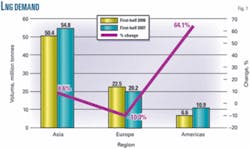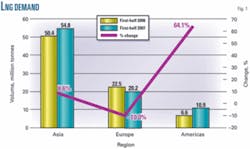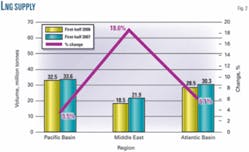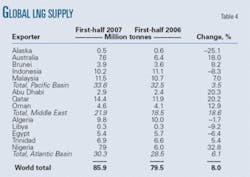Sluggish European LNG demand helped relax supply tensions in the first half of 2007, despite numerous liquefaction plants producing below nameplate capacity. LNG cargoes were pulled away from initially targeted European markets and redirected to higher-priced US or Asian markets.
Outside of an exceptionally early cold winter or supply disruptions, the LNG market should remain relatively relaxed. In addition to greater volumes from Equatorial Guinea, Trinidad, and Norway, European demand will likely remain sluggish, freeing supply for the Asian market.
The price-driven nature of the US market will produce record spot trading activity between the Atlantic and Asia Pacific basin in 2007.
LNG demand
Initial estimates for first-half 2007 show global LNG demand at 86 million tonnes, a 6.3 million tonne, or 8%, increase compared to the first half of 2006. Demand was stronger in the second quarter of the year, growing by 8.8% on the strength of Asian and US buying.
Deliveries to the Asia-Pacific region increased by 2.5 million tonnes (10.5%) in second-quarter 2007 as compared to the same period a year earlier, reaching nearly 55 million tonnes by the end of June 2007. European LNG demand continued to collapse, falling nearly 12% in the second quarter, with cargoes making their way to the US instead, leading to a record high level of LNG imports to the Americas, up 64.1% in the first half of 2007 (Fig. 1).
Asia-Pacific
LNG demand in the Asia-Pacific region increased by 8.6% to 54.8 million tonnes in the first half of 2007 from 50.4 million tonnes in the first half of 2006 (Table 1).
Japan, the world’s largest LNG market, continued to show solid growth, with a 9.8% increase in imports in second-quarter 2007, compared to the same period in 2006. Economic recovery and attractive LNG prices compared to oil prices drove industrial demand, while power generation sector demand was bolstered by a series of nuclear plant closures.
LNG imports into Korea totaled 13.3 million tonnes in the first half of 2007, a decrease of nearly 9% compared to a year ago, as warm temperatures, technical problems at four major storage tanks at the Incheon terminal, and fuel-substitution curbed demand.
In Taiwan, LNG import growth slowed in second-quarter 2007 to 4.8%, following a strong 19.6% demand increase for the same period in 2006. LNG demand in the country totaled 3.7 million tonnes at the end of June 2007, drawn mainly into the power generation sector.
Indian LNG demand remains extremely strong, showing 70.7% growth in second-quarter 2007, and reaching 4.1 million tonnes at the year’s midpoint. The country has been very active in the spot LNG market and imports are nearing the maximum capacity of Petronet LNG’s 5 million tonne/year Dahej terminal, and Shell-Total’s 2.5 million tonne/year Hazira terminal.
CNOOC’s Guangdong terminal received its first Australian cargo in late May 2006. Imports have grown rapidly in 2007, with the buildup of Northwest Shelf production, and totaled 1 million tonnes at the end of June 2007. China also entered the spot LNG market, receiving its first cargo from Oman in April 2007.
Europe
European LNG imports were down 2.3 million tonnes in the first half of 2007 compared to 2006. Exceptionally warm temperatures since fall 2006 curbed demand for heating in most Western European countries last winter, whereas first-quarter 2006 was colder than average. Hydrogeneration also increased in many European countries, thanks to heavier rainfalls. As a result, LNG imports fell nearly 12% in second-quarter 2007 as compared to second-quarter 2006.
In Belgium, Algerian LNG imports under a 3.3 million tonne/year contract have ceased, replaced in April 2007 by a 2 million tonne/year long-term contract between RasGas II and Distrigas. Low gas prices at the Zeebrugge Hub have, however, failed to attract complementary spot cargoes.
In the UK, the start of two new pipelines at yearend 2006 (Langeled, 2.4 bcfd from Norway in September 2006, and the 1.5 bcfd Dutch Interconnector in December 2006) opened additional natural gas supply routes to the country, contributing to a decline in UK gas prices and deterring LNG imports despite the start of Excelerate’s Teesside on-board regasification terminal in February 2007.
Only two European countries, Turkey and Portugal, increased LNG imports in the first half of 2007. Turkey’s LNG demand rose 27.5%, from 1.9 million tonnes to 2.4 million tonnes, mostly making up for volumes lost due to pipeline supply disruptions from Iran.
Americas
Warm weather in Western Europe led to record LNG imports in the Americas, as the US confirmed its position as market-of-last-resort. LNG demand in the Americas increased by 4.2 million tonnes, or 64%, in the first half of 2007 compared with the same period in 2006, due to US demand.
Mexico imported 800,000 tonnes into the Altamira LNG terminal in the first half of 2007 from Nigeria, Egypt, and Trinidad.
Demand in Puerto Rico and the Dominican Republic also increased slightly in the first half of 2007, as the countries took advantage of the generally more plentiful Atlantic Basin supplies.
LNG supply
The largest supply growth occurred in the Middle East at 18.6%, followed by the Atlantic Basin at 6.1%, and Pacific Basin at 3.5% (Fig. 2).
Qatar replaced Indonesia as the world’s largest LNG producer with 14.4 million tonnes of supply put into the market during the first half of 2007, the increase coming mostly from the start of RasGas Train 5 in December 2006. Overall Qatari production increased about 2.5 million tonnes compared with the first half of 2006. LNG supply in Oman and Abu Dhabi also increased by 20% each compared to the first half of 2006.
Nigeria showed the strongest growth in the Atlantic basin, with production increasing by nearly 2 million tonnes, to 7.9 million tonnes in the first half of 2007. Nigerian production growth came mostly from renewed operations at NLNG Train 4 in December 2006 and Train 5 during first-quarter 2007, both of which had experienced production problems in 2006.
Algerian production increased 5.6% in second-quarter 2007, which brought exports for the first half of 2007 to the same level as the year-earlier period. Libyan exports were also virtually flat year-to-year, while Egyptian production dropped 22.4% in second-quarter 2007 compared with the same period in 2006. Egypt’s Damietta plant experienced technical difficulties, leading to an overall reduction of 370,000 tonnes of LNG during the first 6 months of 2007.
The Pacific Basin posted the smallest nominal production increase (1.12 million tonnes). The start of the Darwin liquefaction plant in February 2006, and its production ramp-up in 2006, allowed Australia to increase exports by 18% in the first half of 2007. In Malaysia, LNG production from the Bintulu complex rose 7% in the first half of 2007 due to 21.5% second-quarter growth.
Indonesian LNG supply decreased 10.8% in second-quarter 2007, following a 6% first-quarter drop in the face of continued production problems. During the first 6 months of 2007, Indonesian supply dropped 1 million tonnes as compared with the first half of 2006.
Brunei increased its supply by 300,000 tonnes in the first half of 2007 compared to the year-earlier period.
Outlook
Lower LNG imports into Europe should continue until winter. Wet spring 2007 weather helped boost European hydropower reserves, and mild summer temperatures lowered power generation demand for air conditioning in Western Europe. Demand, however, is likely to increase slightly in Southeastern Europe (Italy, Greece, and Turkey) due to the summer heat wave experienced in the region.
Comfortable European storage levels as winter begins could help sustain imports to the US, although the spread between North European and Henry Hub market prices that ha emerged since the end of September 2007 provides incentive for cargo redirections to northern Europe.
Asian LNG demand, by contrast, will spike late in the year. In addition to the region’s natural LNG demand growth, Japan needs to secure additional LNG as a result of ongoing nuclear power outages. TEPCO alone plans to procure an additional 1.3 million tonnes of LNG by March 2008, as it scrambles to make up for output lost following the July 16 closure of its 8.21 Gw Kashiwazaki-Kariwa nuclear plant in the wake of the 6.8 magnitude Chuetsu offshore earthquake.
New supply
All incremental supply in the immediate term will come from the Atlantic Basin, especially from two greenfield projects.
In Trinidad and Tobago, Atlantic LNG Train 4, which had experienced numerous technical and supply problems since its start-up in December 2005, could finally reach its full 5.2 million tonne/year nameplate capacity after October 2007, when new fields are due to start feeding the plant.
The first cargo from Equatorial Guinea’s LNG plant (3.7 million tonne/year nameplate capacity) was lifted in late May 2007, and the plant is now reported to be running at more than 3 million tonnes/year. BG has rights to the first train’s entire output and has been marketing the volumes to the US. Some cargoes, however, are likely to make their way to Europe and Asia if prices justify the diversion.
Statoil’s 4.1 million tonne/year Snohvit LNG project at Melkoya, Norway, is also on schedule to start shipping regular cargoes by December 2007.
Nigerian LNG Train 6 (4.1 million tonnes/year), however, initially scheduled to start-up by yearend 2007, is now expected to not start-up until first-quarter 2008, after peak winter demand.
The author
Cecile Jovene is principal consultant and head of gas team at FACTS Global energy, Honolulu. Before joining FGE, she was a senior executive with Gaz de France, where she was responsible for procuring the company’s southern supplies. This included negotiating bilateral short-term contracts with gas producers, developing Gaz de France’s LNG trading activities in the Mediterranean basin, and optimizing the company’s Spanish assets by OTC gas and LNG contracts. She holds degrees in management, finance, and business.








